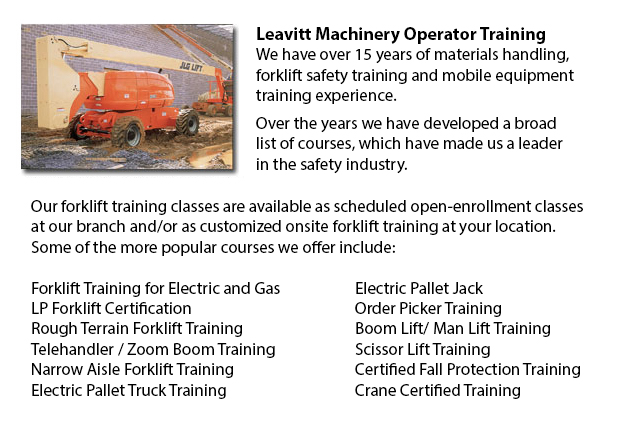
Brampton Aerial Boom Lift Training - Aerial Boom Lift Training is necessary for any person who operates, supervises or works near boom lifts. This type of aerial lift or aerial work platform is for lifting individuals, tools and materials in projects requiring a long reach. They are normally used to access utility lines and other above ground job-sites. There are various types of aerial booms lifts, like extension boom lifts, cherry pickers and articulating boom lifts. There are two types of boom lift: "knuckle" and "telescopic".
Training in the fundamental operations, equipment and safety problems involved in boom lifts is essential. Workers should understand the safe work practices, rules and dangers while working among mobile machinery. Training course materials provide an introduction to the terms, applications, concepts and skills necessary for workers to acquire experience in boom lift operation. The material is aimed at safety professionals, workers and equipment operators.
For your company needs, this training is adaptive, cost-effective and educational and will help your workplace become safer and more effective, allowing for higher levels of production. Less workplace accidents happen in workplaces with strict safety policies. All machine operators must be trained and evaluated. They need understanding of existing safety measures. They have to comprehend and follow rules set forth by the local governing authorities and their employer.
It is the responsibility of the employer to ensure that personnel who must utilize boom lifts are trained in their safe use. Every different kind of workplace machine requires its own machine operator certification. Certifications are available for aerial work platforms, articulating booms, industrial forklift trucks, scissor lifts, and so on. Completely trained workers work more efficiently and effectively than untrained personnel, who need more supervision. Correct training and instruction saves resources in the long run.
The best prevention for workplace deaths is right training. Training can help prevent falls, electrocutions and collapses or tip overs. Other than obtaining the necessary training, workplace accidents could be better prevented by utilizing the aerial work platforms based on the instructions of the manufacturer. Allow for the total weight of the worker, tools and materials when following load restrictions. Never override mechanical, electrical or hydraulic safety devices. Employees should be held securely within the basket making use of a body harness or restraining belt with an attached lanyard. Do not move lift machine when workers are on the elevated platform. Employees should take care not to position themselves between the basket rails and joists or beams in order to avoid being crushed. Energized overhead power lines must be at least 10 feet away from the lift equipment. It is recommended that employees always assume wires and power lines may be energized, even if they appear to be insulated or are down. If working on an incline, set brakes and utilize wheel chocks.
-
Brampton Aerial Boom Lift Ticket
Brampton Aerial Boom Lift Ticket - Aerial lift trucks might be used to accomplish several different tasks executed in hard to reach aerial places. Many of the tasks associated with this style of jack include performing routine maintenance on building... More -
Brampton Aerial Lift Train the Trainer
Brampton Aerial Lift Train the Trainer - The Aerial Lifts Train the Trainer Certification Program would teach trainers how to efficiently train operators in safe industrial mobile equipment operation. Trainers are provided with in-depth instruction o... More -
Brampton Zoom Boom Training
Brampton Zoom Boom Training - Zoom Boom Training is intended to train operators on variable reach forklifts. The goals of the training are to be able to impart an understanding of the physics of the machinery, and to be able to outline the operator's... More -
Brampton Heavy Equipment Operator Training
Brampton Heavy Equipment Operator Training - Heavy equipment operator training facilities that provide good standards within the industry, providing field performance work and additional machinery training are really sought after training features. S... More -
Narrow Aisle Forklift / Order Picker Training / Electric Pallet Jack / Electric Pallet Truck Training in Brampton
A pallet haul is equipment built in particular for moving pallets of irregular weights and dimensions. They may be used in conjunction with cranes, forklifts and other heavy duty equipment as an appendage piece or to be employed on their own. Pallet... More -
Brampton Overhead Crane Safety Training
Brampton Overhead Crane Safety Training - Overhead crane safety training equips operators with knowledge and skills regarding crane safety measures, accident avoidance, materials handling, and equipment and stock protection. Trainees will learn the k... More -
Brampton Crane Safety Training
Brampton Crane Safety Training - Companies and crane drivers have to know the problems associated to crane safety. Legislation provides rules for the safe maintenance, operation and inspection of lifting machines across North America. Crane Safety co... More -
Brampton Telehandler Training
Brampton Telehandler Training - Telescopic handlers normally known as telehandlers for short, are a really popular piece of heavy construction machinery. They are usually utilized in the construction and agricultural trades. These machines have farth... More

Forklift Certification Brampton
TOLL FREE: 1-888-254-6157
Brampton, Ontario
forkliftcertificationbrampton.com
Email Us
About Us


